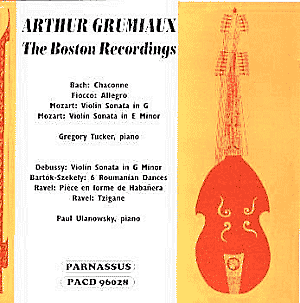AVAILABILITY
www.parnassusrecords.com
These are amongst Grumiaux’s least well-documented
recordings and are fully deserving of their return to the catalogue
in Parnassus’ splendid restoration. They coincided with his first American
tour, which began in the 1951-52 season and proved successful though
in later years Grumiaux preferred to cut back on touring commitments.
He was approaching thirty and had already made a number of recordings,
not least some for Columbia in London (Leslie Gerber errs slightly in
his belief that they were made for French Columbia; they were amongst
the Philharmonia’s earliest recordings and the Bach Double with the
distinguished British violinist Jean Pougnet is especially attractive).
The recordings here derive from two Boston LPs and contain principally
canonical Grumiaux repertoire, works that would appear again in his
discography.
Thus for example the disc starts with the Bach Chaconne.
This is a slightly slower performance than his 1961 traversal of the
complete Sonatas and Partitas made for Philips, with whom he had so
congenial and fruitful a relationship. But the tone itself is, a decade
earlier, more intense and coiled, and the chordal phrasing of sonorous
and leonine power. That he should be so commanding a Bach player should
come as no surprise – his teachers, Alfred Dubois and Enescu, were amongst
the leading Bachians of their own generation. In the Boston performance
one can also note the subtly increased bow pressure he applies vis a
vis the later recording, the sense also of greater romantic expressivity.
He was always taken by Fiocco’s little Allegro, an agreeable piece of
baroquerie so beloved of fiddlers, and recorded it later for Philips.
This earlier performance is slightly less elegant, less floated, more
obviously romantic with, once again, Grumiaux digging that bit harder
into the string than he was later to do. I prefer the later Philips
recording; it has a strong but patrician charm but this earlier one
has real presence and strength (and my favourite of all recordings of
it is an acoustic 78 by the then leader of the London String Quartet,
Jimmy Levey, who catches its quirks to a T). His Mozart was and remains
wonderful; some, I know, find it rather blithe and uncolourful but the
sheer ease, naturalness and affection of the Allegro con spirito
of the Sonata in G K301 is treasurable (George Tucker the alert pianist),
the flexibility of his diminuendos a sign of a superior intellect and
tonalist at work. In the other essayed Sonata, the E minor, K304, the
elasticity of his line in the Tempo di minuetto, its absolute
sustenance, and the expressive sensitivity of his shaping corroborates
the views of those who hold up his Mozart as model playing. If only
the edits here hadn’t been so poor – but they were, I suppose, inherent
in the master copy.
The Debussy Sonata in G was always one of his most
cogent and expressive calling cards. The consistent subtlety of his
playing of the Franco-Belgian repertoire was for a generation a cut
above most of his contemporaries. He was to re-record the Debussy for
Philips with the excellent Riccardo Castagnone four years later. For
the Boston LP with Paul Ulanowsky, himself a pianist of distinction
and an accompanist to the finest, Grumiaux is slightly but consistently
faster than he was to become. But no breathlessness is imparted, no
sense of rhythmic inflexibility, no hint of phrasal insensitivity. His
vibrato is immaculately controlled here, its usage incrementally increased
dependent on the expressive potential inherent in the music. Ulanowsky
proves a fine and notably sensitive partner.
The Bartók is a discographic first-and-only.
He never returned to it so Grumiaux lovers will want to hear it and
they will hear a persuasively biting performance, full of temperament
and lavish intensity, though one always constrained by observance of
correct vibrato usage. Tzigane is shorn of the opening cadenza but we
can still appreciate his swagger – he was not at all, then or subsequently,
incapable of Slavic bite as is quite evident here.
This is an admirable release that reprints the original
Boston LP notes and adds a few pertinent biographical details. It fills
a lacuna in Grumiaux’s earlier years, catching him mid-way between the
English Columbias and the Philips contract that soon beckoned. Again
and again I turn to Grumiaux for some of the most lofty and beautiful
playing of his generation and I shall turn to this disc with equal excitement
and pleasure.
Jonathan Woolf

